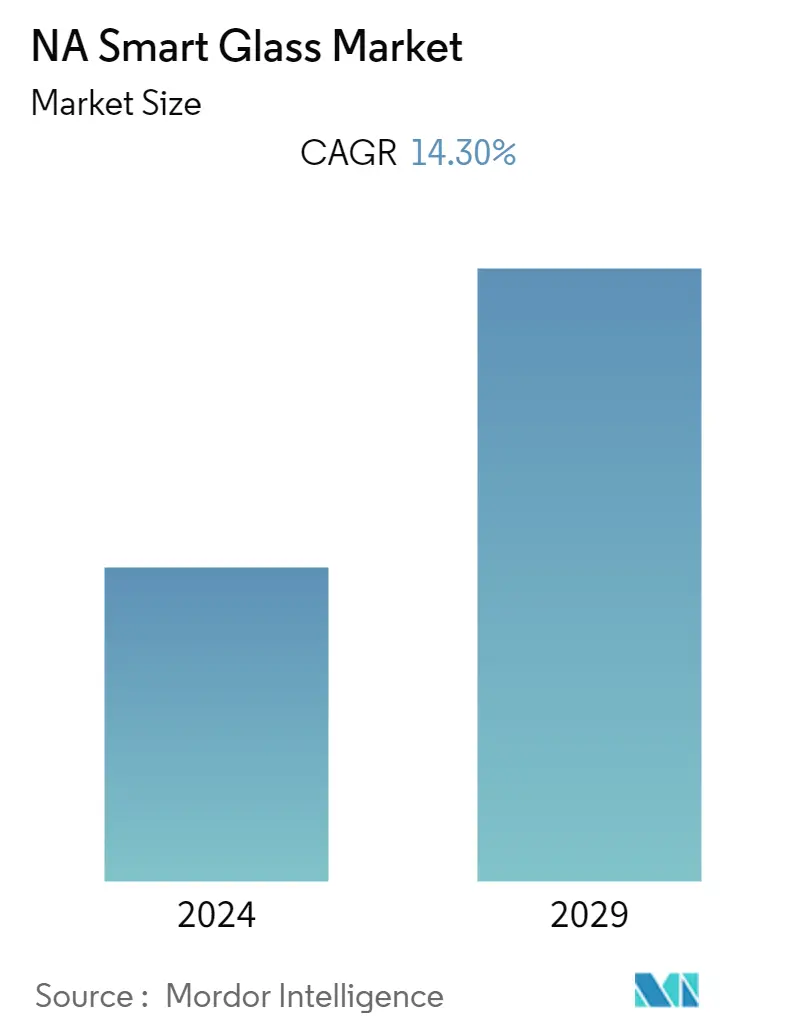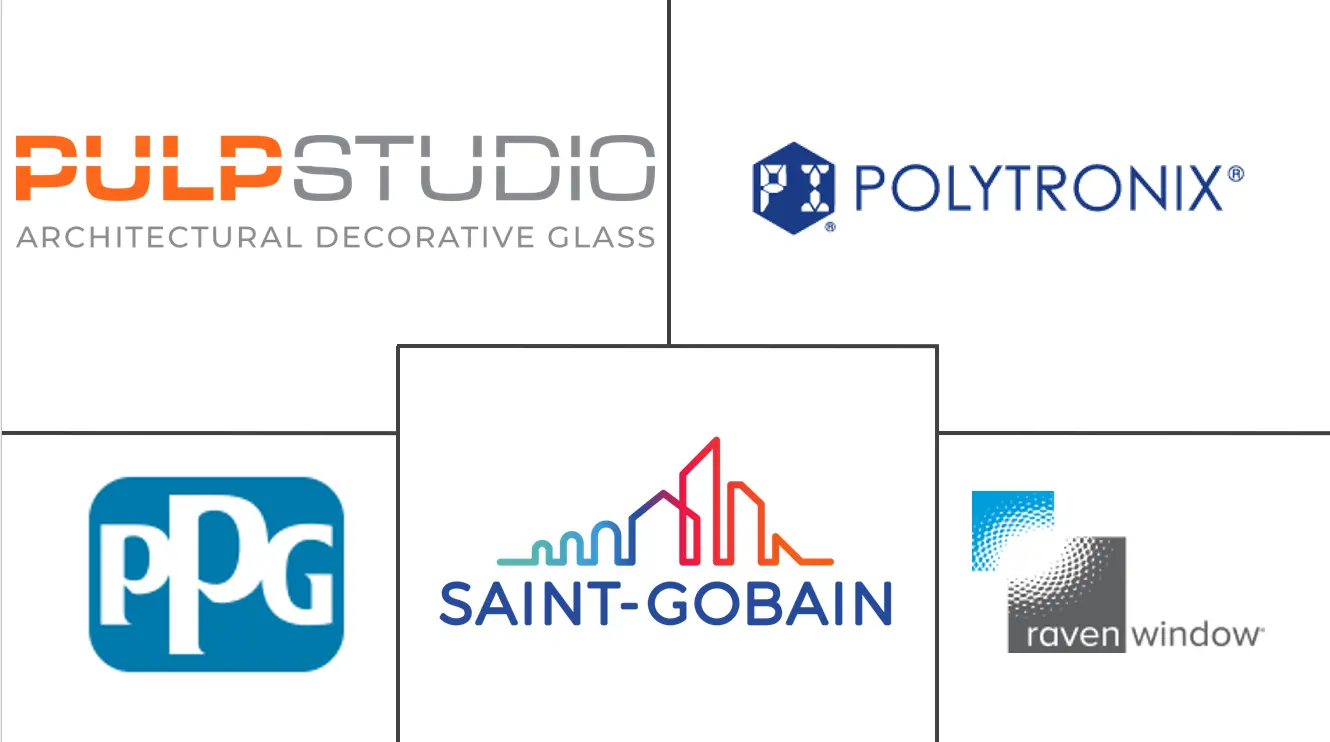Market Size of NA Smart Glass Industry

| Study Period | 2019 - 2029 |
| Base Year For Estimation | 2023 |
| Forecast Data Period | 2024 - 2029 |
| Historical Data Period | 2019 - 2022 |
| CAGR | 14.30 % |
| Market Concentration | Low |
Major Players
*Disclaimer: Major Players sorted in no particular order |
North America Smart Glass Market Analysis
The North American smart glass market is estimated to grow at a CAGR of 14.3% in the forecasted period (2021-2026). The smart glass market in the region has been gaining significant traction due to the surging demand for energy cost savings in high-end commercial offices and residential spaces. With a growing focus on sustainable development, an increasing number of people have been opting for user-controlled windows in buildings, due to which Smart glass manufacturers have been actively investing in research and development in the region to cut production costs by implementing newer technologies and low-cost raw materials.
In recent years, several offices, hotels, and residential homes have had smart glass installed in their premises. With more and more companies getting involved in the smart glass market in North America, the market has been heating up. Also, smart glass has been witnessing higher adoption in the Transportation industry. For instance, Boeing 787 Dreamliner uses smart glass so that the passengers and the in-flight crew can select the amount of sunlight coming through to their liking.
The construction industry holds the largest market share in the North American smart glass market, owing to the increasing demand for smart glasses in architecture and the improving real estate market in the region. Architects are increasingly using this type of glass to reduce the energy consumption of the building, due to which there have been increasing developments in the construction industry on smart glasses in the region.
The growing consciousness among individuals for the conservation of energy has gained a lot of impetus from a wide region of sources. Humans, for several centuries, have exploited non-renewable resources, which, in turn, has led to the depletion of these precious fossil fuels. This major concern helps the smart glass obtain a huge market for themselves, as they help save electricity without harming the environment or its resources.
However, one of the major growth restraints for the smart glass industry is its high expenses compared to normal glass. Additionally, lack of awareness of smart glass benefits and the existence of technical issues with the usage of large size smart glass are some of the key impediments hindering the growth of the market.
North America Smart Glass Industry Segmentation
Smart glasses are special types of glasses, which can change from being clear to translucent or even pellucid to opaque. It is primarily used to block light, heat, and glare. This technology is very helpful to reduce the cost of lighting, air conditioning, curtains blinding, or heating of the room. There are two types of smart glasses: active type and passive type. The active type of smart glass responds to the electrical stimulus to make the glass, while the passive type is triggered by light or heat. Active glasses are used in sectors like architecture, healthcare, and automotive, etc. This type of smart glass uses technologies like Suspended Particle Devices (SPDs) and electrochromic devices.
| Technology | |
| Suspended Particle Devices | |
| Liquid Crystals | |
| Electro-chromic Glass | |
| Passive Smart glass | |
| Active Smart glass | |
| Others |
| Applications | ||||||
| ||||||
| ||||||
| Energy | ||||||
| Consumer Electronics | ||||||
| Others |
| Country | |
| United States | |
| Canada |
NA Smart Glass Market Size Summary
The North American smart glass market is experiencing significant growth, driven by the increasing demand for energy-efficient solutions in both commercial and residential sectors. This surge is largely attributed to the rising emphasis on sustainable development and energy conservation, prompting a shift towards user-controlled windows. Smart glass technology, which includes features like electrochromic coatings that adjust tinting based on sunlight, is becoming a popular choice in the construction industry. This sector holds the largest market share due to its focus on reducing energy consumption and improving building efficiency. The adoption of smart glass is also expanding in the transportation industry, with applications such as the Boeing 787 Dreamliner, where it enhances passenger comfort by allowing control over sunlight exposure.
Despite its benefits, the smart glass market faces challenges, including higher costs compared to traditional glass and limited awareness of its advantages. However, government incentives and stringent building codes in the United States are fostering a favorable environment for market growth. The market is characterized by a competitive landscape with established international brands, domestic players, and new entrants actively pursuing expansion through strategic partnerships and innovations. The ongoing developments in smart glass technology and its increasing integration into various sectors are expected to drive further demand in the region, aligning with the broader goals of energy efficiency and environmental sustainability.
NA Smart Glass Market Size - Table of Contents
-
1. MARKET INSIGHTS
-
1.1 Market Overview
-
1.2 Value Chain Analysis
-
1.3 Porter's Five Forces Analysis
-
1.3.1 Threat of New Entrants
-
1.3.2 Bargaining Power of Buyers
-
1.3.3 Bargaining Power of Suppliers
-
1.3.4 Threat of Substitutes
-
1.3.5 Intensity of Competitive Rivalry
-
-
1.4 Impact of COVID-19 on the Market
-
-
2. MARKET SEGMENTATION
-
2.1 Technology
-
2.1.1 Suspended Particle Devices
-
2.1.2 Liquid Crystals
-
2.1.3 Electro-chromic Glass
-
2.1.4 Passive Smart glass
-
2.1.5 Active Smart glass
-
2.1.6 Others
-
-
2.2 Applications
-
2.2.1 Construction
-
2.2.1.1 Residential Buildings
-
2.2.1.2 Commercial Buildings
-
-
2.2.2 Transportation
-
2.2.2.1 Aerospace
-
2.2.2.2 Rail
-
2.2.2.3 Automotive
-
2.2.2.4 Others
-
-
2.2.3 Energy
-
2.2.4 Consumer Electronics
-
2.2.5 Others
-
-
2.3 Country
-
2.3.1 United States
-
2.3.2 Canada
-
-
NA Smart Glass Market Size FAQs
What is the current NA Smart Glass Market size?
The NA Smart Glass Market is projected to register a CAGR of 14.30% during the forecast period (2024-2029)
Who are the key players in NA Smart Glass Market?
Polytronix Inc, PPG Industries, Saint-Gobain, Pulp Studio and RavenBrick LLC are the major companies operating in the NA Smart Glass Market.

